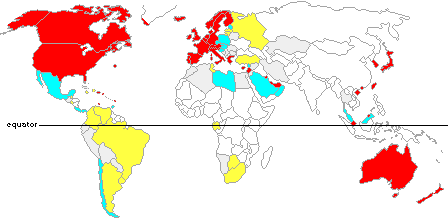
The Power of Stupidity
“Views of the World”
(It isn’t just a matter of geography)
Giancarlo Livraghi – February 2005
(Updated
March 2009)
A supplement to
The Power of Obscurantism
and also to Problems of Perspective
(Chapter 21 of The
Power of Stupidity)
We are often confused by problems of perspective. We can have a “ptolemaic” point of view even though we don’t believe that the Earth is the center of the universe. While we may understand (at least in theory) the general concepts of astronomy and geography, we tend to look at things from where we are, not only physically, but also under the influence of “belonging” to a culture, a circle of friends, neighbors and habits, as well as our personal perceptions and prejudices.
It’s instinctive, to some extent unavoidable, for each one of us to see everything from our (physical or mental) position. It’s intellectually correct, in a “relativistic” concept, to think that any possible point in space ant time can be chosen as center of the perceivable universe. It’s pretty obvious that our state of awareness is a shifting point of contact between an inside and an outside “world.” But we need to understand that it’s only one of the infinite possible viewpoints – and there isn’t much that we can learn if we don’t know how to look also from different perspectives
This two little examples are deliberately elementary and oversimplified. They may not mean much per se, but they show how the use of language can reveal a twisted way of thinking.
It’s a widespread habit to say “north” or “south” of the world to mean the difference between “rich” or “poor” countries or regions. An elementary knowledge of geography tells us that it simply isn’t so. This isn’t only an oversimplification (that, in any case, doesn’t help to understand problems) but also a symptom of how things can be seen upside down.
There are “rich” economies in the southern hemisphere as there are poorly developed countries, and other serious problems, in northern Asia. The north-south criterion is meaningless, often reversed, when we try to understand what is happening in Africa – or Latin America. Just as there are, in individual countries, several cases of “south” doing better than “north”.
This isn’t just a matter of language or geography. People living in Europe or North America often don’t understand the rest of the world – and vice versa.
A quick glance at an approximate world map can help to realize that the picture is quite different.

Obviously a rough economic average isn’t good enough
to understand “wellbeing” and human conditions.
But this is what we get from general statistics.Red shows countries with estimated per capita “income”
(gross national product) over 10,000 US dollars.
Blue between 4,000 and 10,000.
Yellow 2,000 – 40,000. Grey 1,000 – 2,000.
Fourteen of the fifteen countries worldwide
with total “income” (GNP) over a thousand billion dollars
are in the northern hemisphere.
But this doesn’t justify the misleading “north-south” notion.
Though this oversimplified map obviously doesn’t reflect the complexities of the situation, at least it shows that the picture can’t be understood by merely considering latitude. The number of people in severely depressed situations living on the north side of the equator is much larger than south. We need other criteria to understand where and how there are serious problems to be solved.
Another example is in the reporting of the seismic wave (also called “seaquake” or “tsunami”) in the Indian Ocean in December 2004. In some European countries (such as Italy) all mainstream media placed that tragedy in “Southeast Asia”. If we are looking from Europe, that is the perspective. But it isn’t if (as, of course, we should) we see it from the point of view of Asia. It was, indeed, south. But not east.
Blue shows the places hit by the seismic wave.
Yellow is the area that can be correctly called “Southeast Asia”.
Most of southeast Asia was not involved in this catastrophe. The wave hit west, all the way to the coast of Africa. Of course knowing where it happened was only one of several factors in understanding what, how and why, but also other facts were misinterpreted or poorly reported – in this case as in all sorts of situations.
Someone living in London can correctly say that Amsterdam is to the east. But that doesn’t place the Netherlands in Eastern Europe. Mexico is south of the USA – but not (as some people think and say) in South America. Etcetera. Whenever we observe an event or a situation it’s always better to try to understand it from the point of view of the people involved. That, of course, isn’t only a matter of north or south, east or west. But it would help if we were more often in the habit of looking at a map.
Are these irrelevant details? Not really. They are examples of warped perspective, of how things are often perceived in a restricted and disoriented manner. Even when we know exactly (or so we think) the whereabouts of whatever we are considering, we can miss a lot of the meaning if we are looking at it from only one angle.
A third example is so elementary that it may seem silly. Let’s look at east and west in a way that is different from most world maps. This one shows the Pacific Ocean (that covers a third of the Earth’s total surface.)
As seen from America, the “Far East” is west. As seen from Asia, America is east. Is this obvious? Yes. But do we stop and think, as often as we should, when we are trying to understand how some part of the world relates to another? “Cardinal points” are generally set as seen from Europe. In another perspective, things can look quite different.
There can be infinite examples. And, of course, cultural differences can be more important than geography.
Two intriguing drawings by an extraordinary artist, Saul Steinberg, explain this problem quite effectively. They are covers of The New Yorker magazine – on October 12, 1963 and March 29, 1976.

Copyright © Saul Steinberg – The New Yorker
The first is a conversation between two ladies. One is from Paris – and her environment is a few streets in her home city. The other lives in Sardinia – and she is talking about the whole island. Both are thinking from their local point of view.The second New Yorker cover is much more famous. It shows the world as seen by someone living in midtown Manhattan and looking west, in a perspective that becomes very narrow after it crosses the Hudson.
It has been reproduced and quoted countless times – and it has inspired several other pictures, by different artists, of how things are seen from cities around the world.
Post Scriptum – March 2009
A recent variation on this theme is the cover of The Economist on March 21, 2009. The world as seen from China (central Beijing.) Looking east to see its perception of “The West.”
«With apologies to Steinberg and The New Yorker»
Copyright © 2009 The EconomistSome interesting details can be seen more clearly
in a larger image
Obviously this is isn’t only about China – or only a problem of large distance. We often lack perspective on situations, environments and cultures that are (or so we think) much closer.
In spite of the fact that communication systems are (or appear to be) faster that they have ever been, perspective problems remain – and in several cases they are getting worse.
Let’s remember Steinberg’s drawings. And draw our own in our minds, trying to look at things from different angles. Changing perspective can be quite amusing. And we often learn a lot by doing so.